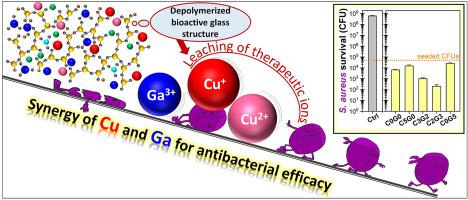Journal of Materiomics ( IF 8.4 ) Pub Date : 2022-01-01 , DOI: 10.1016/j.jmat.2021.12.009 T. Tite 1 , A.C. Popa 1 , B.W. Stuart 2 , H.R. Fernandes 3 , I.M. Chirica 1 , G.A. Lungu 1 , D. Macovei 1 , C. Bartha 1 , L. Albulescu 4 , C. Tanase 4 , S. Nita 5 , N. Rusu 5 , D.M. Grant 2 , J.M.F. Ferreira 3 , G.E. Stan 1

|
The incorporation of therapeutic-capable ions into bioactive glasses (BGs), either based on silica (SBGs) or phosphate (PBGs), is currently envisaged as a proficient path for facilitating bone regeneration. In conjunction with this view, the single and complementary structural and bio-functional roles of CuO and Ga2O3 (in the 2–5 mol% range) were assessed, by deriving a series of SBG and PBG formulations starting from the parent glass systems, FastOs®BG – 38.5SiO2—36.1CaO—5.6P2O5—19.2MgO—0.6CaF2, and 50.0P2O5—35.0CaO—10.0Na2O—5.0 Fe2O3 (mol%), respectively, using the process of melt-quenching. The inter-linked physico-chemistry – biological response of BGs was assessed in search of bio-functional triggers. Further light was shed on the structural role – as network former or modifier – of Cu and Ga, immersed in SBG and PBG matrices. The preliminary biological performance was surveyed in vitro by quantification of Cu and Ga ion release under homeostatic conditions, cytocompatibility assays (in fibroblast cell cultures) and antibacterial tests (against Staphylococcus aureus). The similar (Cu) and dissimilar (Ga) structural roles in the SBG and PBG vitreous networks governed their release. Namely, Cu ions were leached in similar concentrations (ranging from 10–35 ppm and 50–110 ppm at BG doses of 5 and 50 mg/mL, respectively) for both type of BGs, while the release of Ga ions was 1–2 orders of magnitude lower in the case of SBGs (i.e., 0.2–6 ppm) compared to PBGs (i.e., 9–135 ppm). This was attributed to the network modifier role of Cu in both types of BGs, and conversely, to the network former (SBGs) and network modifier (PBGs) roles of Ga. All glasses were cytocompatible at a dose of 5 mg/mL, while at the same concentration the antimicrobial efficiency was found to be accentuated by the coupled release of Cu and Ga ions from SBG. By collective assessment, the most prominent candidate material for the further development of implant coatings and bone graft substitutes was delineated as the 38.5SiO2—34.1CaO—5.6P2O5—16.2MgO—0.6CaF2—2.0CuO—3.0Ga2O3 (mol%) SBG system, which yielded moderate Cu and Ga ion release, excellent cytocompatibility and marked antibacterial efficacy.
中文翻译:

二氧化硅和磷酸盐基生物活性玻璃中作为治疗剂的 CuO 和 Ga2O3 的独立和互补的生物功能效应
目前设想将具有治疗能力的离子结合到基于二氧化硅 (SBG) 或磷酸盐 (PBG) 的生物活性玻璃 (BG) 中,作为促进骨再生的有效途径。结合这一观点,通过从母体玻璃衍生一系列 SBG 和 PBG 配方,评估了 CuO 和 Ga 2 O 3 (在 2-5 mol% 范围内)的单一和互补结构和生物功能作用FastOs®BG – 38.5SiO 2 —36.1CaO—5.6P 2 O 5 —19.2MgO—0.6CaF 2和 50.0P 2 O 5 —35.0CaO—10.0Na 2 O—5.0 Fe 2 O 3(mol%),分别采用熔融淬火工艺。为了寻找生物功能触发因素,评估了 BG 的相互关联的物理化学 - 生物反应。进一步阐明了浸入 SBG 和 PBG 基质中的 Cu 和 Ga 的结构作用(作为网络形成剂或改性剂)。通过量化稳态条件下的 Cu 和 Ga 离子释放、细胞相容性测定(在成纤维细胞培养物中)和抗菌测试(针对金黄色葡萄球菌),在体外调查了初步的生物学性能)。SBG 和 PBG 玻璃体网络中相似 (Cu) 和不同 (Ga) 的结构作用决定了它们的释放。即,对于两种类型的 BG,Cu 离子的浸出浓度相似(分别为 10-35 ppm 和 50-110 ppm,BG 剂量分别为 5 和 50 mg/mL),而 Ga 离子的释放量为 1-2 SBG(即0.2-6 ppm)与PBG(即, 9–135 ppm)。这归因于 Cu 在两种类型的 BG 中的网络改性剂作用,相反,归因于 Ga 的网络形成剂 (SBGs) 和网络改性剂 (PBGs) 作用。所有玻璃在 5 mg/mL 的剂量下都是细胞相容的,而在相同浓度下,发现 SBG 中 Cu 和 Ga 离子的耦合释放增强了抗菌效率。通过集体评估,用于进一步开发种植体涂层和骨移植替代物的最突出的候选材料被划定为 38.5SiO 2 -34.1CaO-5.6P 2 O 5 -16.2MgO-0.6CaF 2 -2.0CuO-3.0Ga 2氧3(mol%) SBG体系,产生适度的Cu和Ga离子释放,优异的细胞相容性和显着的抗菌功效。











































 京公网安备 11010802027423号
京公网安备 11010802027423号